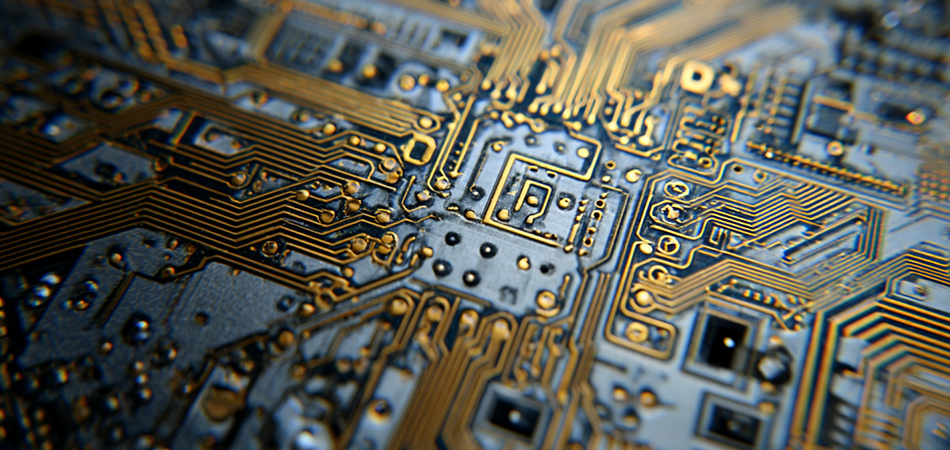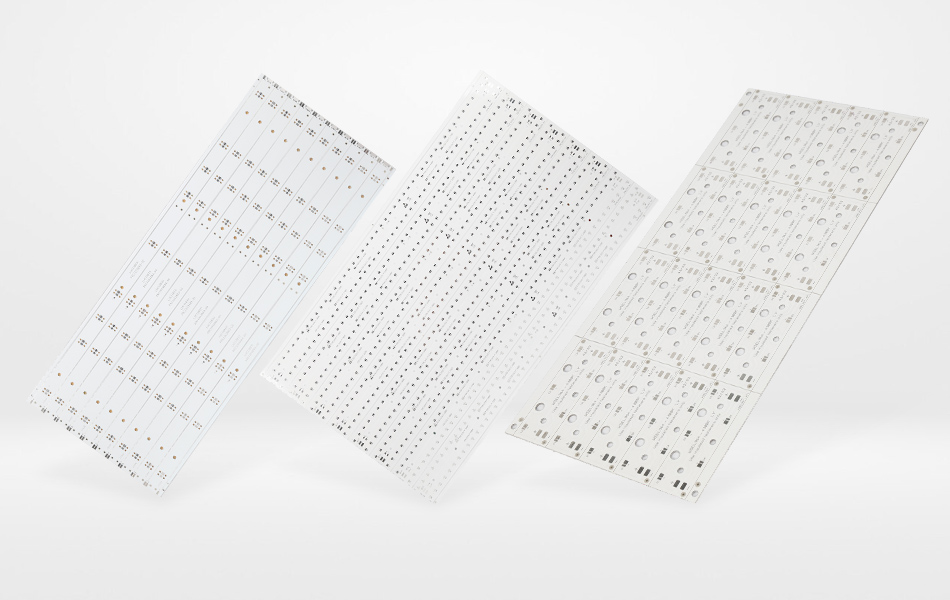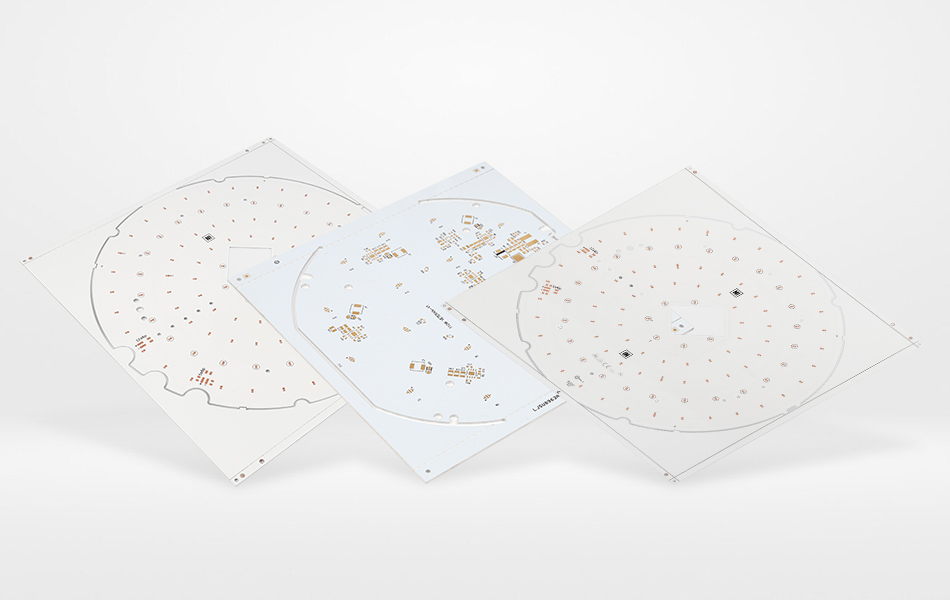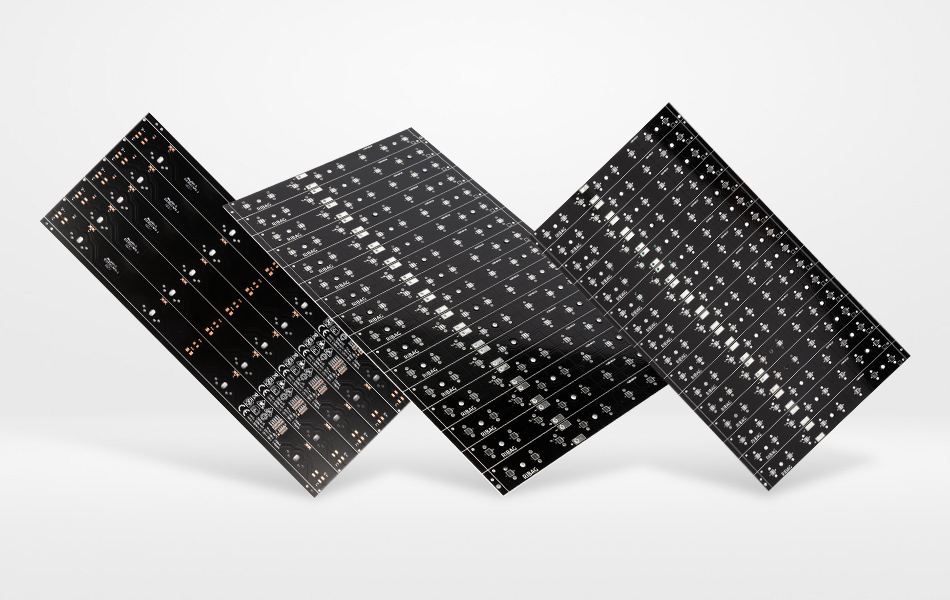-
- PCB TYPE
- PRINTED CIRCUIT BOARD PROTOTYPE ALUMINUM PRINTED CIRCUIT BOARD R&F PCB FPC HIGH FREQUENCY PCB HIGH-TG PCB HEAVY COPPER PCB HDI PCB PCB FOR LIGHTING METAL CORE PCB
time:Jun 21. 2025, 09:32:26
In the rapidly evolving electronics landscape, Printed Circuit Boards (PCBs) act as the linchpin for countless devices, enabling seamless electrical connectivity and signal processing. Among the plethora of PCB materials, aluminum has emerged as a material of choice, giving rise to Aluminum PCBs that are transforming the way electronic products are designed and manufactured. With a unique blend of thermal management capabilities, mechanical robustness, and electrical efficiency, Aluminum PCBs have become integral to a wide array of applications, from consumer gadgets to high - end industrial systems. This article will take an in - depth look at Aluminum PCBs, exploring their fundamental characteristics, design principles, manufacturing processes, diverse applications, market dynamics, and future prospects.
The Fundamental Attributes of Aluminum PCBs
The Role of Aluminum Substrate
At the core of every Aluminum PCB lies the aluminum substrate, which serves as the foundation for its functionality. Aluminum, a lightweight yet sturdy metal, offers several distinct advantages. Its exceptional thermal conductivity allows it to quickly absorb and disperse heat generated by power - consuming components on the PCB. This is particularly crucial in modern electronics, where components are becoming more powerful and generate substantial heat during operation. By efficiently managing heat, Aluminum PCBs prevent thermal stress, which can lead to component failure and reduced device lifespan.
Beyond its thermal benefits, the aluminum substrate provides mechanical strength to the PCB. It can withstand mechanical vibrations, shocks, and other physical stresses, making it suitable for use in environments where standard PCBs might fail. Additionally, the lightweight nature of aluminum is an added advantage, especially in industries such as aerospace and automotive, where minimizing the weight of electronic components is a key consideration.
The Three - Layer Construction
Aluminum PCBs typically feature a three - layer construction. The bottom layer is the aluminum substrate, which provides thermal and mechanical support. Above the aluminum substrate is a thermally conductive dielectric layer. This layer plays a vital role in electrically isolating the aluminum from the electrical traces while facilitating the transfer of heat. It is carefully engineered to have high electrical resistance to prevent short - circuits and good thermal conductivity to ensure efficient heat transfer.
On the top, there is a copper layer that is patterned to form the electrical traces and pads. Copper, known for its excellent electrical conductivity, is used to create the pathways for electrical signals and power distribution. This three - layer structure works in harmony to provide a PCB that can handle both the electrical and thermal demands of modern electronic applications.
Material Synergy for Optimal Performance
The combination of aluminum, the dielectric layer, and copper in an Aluminum PCB creates a synergy that enhances its overall performance. The high thermal conductivity of aluminum, the electrical insulation of the dielectric layer, and the conductivity of copper work together to ensure that the PCB can operate reliably under various conditions. This synergy allows for the design of more compact, powerful, and efficient electronic devices, as the PCB can effectively manage heat and electrical signals simultaneously.

aluminum pcb
Design Principles for Aluminum PCBs
Thermal Design Strategies
Component Placement for Heat Dissipation
In the design of Aluminum PCBs, component placement is a critical factor in thermal management. Heat - generating components should be positioned in a way that maximizes heat transfer to the aluminum substrate. For instance, placing these components in areas with good contact with the substrate or near thermal vias can significantly improve heat dissipation. Components can also be grouped based on their heat - generation levels, with high - heat - producing components placed in areas where heat can be more easily dissipated, such as near the edges of the PCB or close to heat - dissipating structures like heat sinks.
Thermal Via Design and Utilization
Thermal vias are small holes filled with a highly conductive material, usually copper, that connect different layers of the PCB and the aluminum substrate. They play a crucial role in facilitating heat transfer. Designers need to carefully consider the size, number, and distribution of thermal vias based on the heat - generating characteristics of the components. By strategically placing thermal vias, they can create efficient heat - transfer paths, ensuring that heat is quickly conducted away from critical components and dissipated through the aluminum substrate.
Electrical Design Considerations
Trace Routing and Signal Integrity
Trace routing in Aluminum PCBs requires careful planning to ensure signal integrity. The presence of the aluminum substrate can influence the electromagnetic field around the traces, potentially causing signal interference and degradation. For high - speed signals, impedance - controlled traces are often necessary. Designers must take into account factors such as trace width, length, spacing, and the dielectric constant of the insulating layer to calculate and maintain the appropriate impedance values. Specialized design software is commonly used to simulate signal behavior and optimize trace routing for optimal performance.
Power and Ground Plane Design
Power and ground plane design is essential for the proper functioning of Aluminum PCBs. The aluminum substrate can sometimes be utilized as a ground plane, taking advantage of its low resistance and large surface area. Well - designed power and ground planes help to distribute electrical power evenly across the board, reduce electromagnetic interference (EMI), and provide a stable electrical supply to the components. Designers need to ensure that the power and ground planes are continuous, with minimal splits or gaps, and that proper grounding techniques are employed to enhance the overall electrical performance of the PCB.
Design for Manufacturability
To ensure efficient and cost - effective production, Aluminum PCB designs must adhere to the principles of design for manufacturability (DFM). Designers need to consider factors such as the minimum achievable trace width and spacing, the maximum aspect ratio for vias, and the ease of component placement and soldering. By optimizing the design for manufacturability, potential manufacturing issues can be avoided, production costs can be reduced, and the time - to - market can be shortened. This may involve simplifying complex circuit layouts, using standard component footprints, and ensuring compatibility with the manufacturing equipment and processes of the PCB manufacturer.

Manufacturing Processes of Aluminum PCBs
Material Selection
The manufacturing process of Aluminum PCBs begins with the careful selection of materials. High - quality aluminum sheets with consistent thickness and purity are chosen for the substrate. The aluminum should have excellent thermal conductivity and mechanical strength to meet the requirements of the application. For the copper layer, high - purity copper foils are selected for their superior electrical conductivity and surface quality. The thermally conductive dielectric material is also carefully selected based on its electrical insulation properties, thermal conductivity, and adhesion to both the aluminum and copper layers.
Lamination
Lamination is a crucial step in the manufacturing process, where the aluminum substrate, dielectric layer, and copper foil are bonded together. Heat and pressure are applied to cure the dielectric material, creating a strong and cohesive structure. Precise control of lamination parameters, such as temperature, pressure, and time, is essential to ensure a uniform bond and avoid defects such as voids, delaminations, or uneven bonding. Any imperfections in the lamination process can have a significant impact on the thermal and electrical performance of the final PCB.
Drilling and Plating
After lamination, drilling is performed to create holes for vias, component mounting, and electrical connections. High - precision drilling machines are used to ensure accurate hole placement and clean hole walls. Following drilling, the holes are plated with copper to create electrical connections between the different layers of the PCB and to provide a solderable surface for component attachment. The plating process, typically electroplating, requires careful control of parameters such as current density, plating time, and temperature to achieve a uniform and reliable copper deposit.
Circuit Patterning
Circuit patterning is the process of creating the electrical circuits on the copper layer. Photolithography is commonly used for this purpose. A photosensitive resist material is applied to the copper surface, and then a patterned mask is used to expose the resist to ultraviolet (UV) light. The exposed areas of the resist are chemically altered and removed during the development process, leaving the unexposed resist in the shape of the circuit pattern. The remaining copper is then etched away using an etching solution, leaving only the copper traces that form the electrical circuits.

Applications of Aluminum PCBs
LED Lighting
One of the most prominent application areas for Aluminum PCBs is LED lighting. LEDs generate a significant amount of heat during operation, and efficient heat dissipation is crucial for maintaining their luminous efficiency and lifespan. Aluminum PCBs can effectively manage this heat, allowing for the design of more powerful and compact LED lighting fixtures. They are widely used in various lighting applications, including indoor lighting, outdoor streetlights, and decorative lighting, where their ability to dissipate heat and support complex circuit designs is highly valued.
Power Electronics
In power electronics applications, such as power supplies, inverters, and motor drives, Aluminum PCBs are extensively used. These applications involve high - power components that generate substantial heat and require reliable electrical connections. The aluminum substrate in the PCB helps to dissipate the heat effectively, ensuring the stable operation of the power electronics devices. The copper traces on the PCB can handle the high currents involved, providing efficient power transfer and distribution.
Automotive Electronics
The automotive industry has increasingly adopted Aluminum PCBs for a variety of applications. In modern vehicles, there is a growing number of electronic systems, including engine control units (ECUs), advanced driver - assistance systems (ADAS), and infotainment systems. Aluminum PCBs are used in these systems due to their ability to withstand the harsh conditions inside a vehicle, such as high temperatures, vibrations, and electromagnetic interference. Their thermal management capabilities ensure that components operate within safe temperature ranges, while their mechanical strength provides durability during vehicle operation.
Aerospace and Defense
Aerospace and defense applications demand PCBs that can perform reliably in extreme environments. Aluminum PCBs meet these stringent requirements with their high thermal conductivity, mechanical strength, and lightweight properties. They are used in aircraft avionics systems, satellite communication equipment, and military electronics, where the ability to dissipate heat effectively, maintain signal integrity, and withstand mechanical stress is critical for mission success.
Consumer Electronics
In the consumer electronics market, Aluminum PCBs are finding increasing use in devices such as smartphones, tablets, laptops, and gaming consoles. These devices often have power - hungry components that generate a significant amount of heat. Aluminum PCBs help to manage this heat, preventing performance throttling and extending the lifespan of the components. Their lightweight and compact design also contribute to the development of more portable and sleek consumer electronics products.

Market Dynamics of Aluminum PCBs
Market Growth
The global market for Aluminum PCBs has been experiencing steady growth in recent years, and this trend is expected to continue. The increasing demand for energy - efficient LED lighting solutions, the growth of the automotive and aerospace industries, and the continuous innovation in consumer electronics are all significant drivers of market growth. As more industries recognize the benefits of Aluminum PCBs in terms of performance, reliability, and cost - effectiveness, the market is likely to expand further in the coming years.
Competitive Landscape
The market for Aluminum PCBs is highly competitive, with numerous manufacturers vying for market share. Key players in the market include both established PCB manufacturers with a long - standing reputation and emerging companies that are bringing new technologies and innovative approaches to the table. Competition is based on factors such as product quality, performance, cost - effectiveness, technological innovation, and customer service. Manufacturers are constantly investing in research and development to improve the performance of their PCBs, reduce production costs, and offer customized solutions to meet the specific requirements of different customers and industries.

Challenges and Future Trends
Challenges
Despite their many advantages, the Aluminum PCB industry faces several challenges. One of the main challenges is the cost. The use of high - quality materials, especially aluminum and copper, along with specialized manufacturing processes, can result in relatively high production costs. Fluctuations in the prices of raw materials can also impact the cost - effectiveness of production. Additionally, as electronics continue to evolve towards smaller form factors and higher levels of integration, the design and manufacturing of Aluminum PCBs become more complex, requiring more advanced design tools and skilled engineers.
Another challenge is ensuring consistent quality during mass production. The manufacturing process of Aluminum PCBs involves multiple steps, and any variation in these steps can lead to quality issues. Detecting and rectifying these issues in a timely manner is crucial to maintaining the reliability of the PCBs.
Future Trends
The future of Aluminum PCBs is filled with exciting possibilities. Advancements in materials science are expected to lead to the development of new aluminum alloys and composite materials with enhanced thermal and mechanical properties. These new materials could further improve the performance of Aluminum PCBs, enabling the creation of even more efficient and reliable electronic devices.
The integration of emerging technologies, such as 5G, the Internet of Things (IoT), and artificial intelligence (AI), will create new opportunities for Aluminum PCBs. These technologies will require PCBs that can support high - speed data transfer, complex signal processing, and efficient thermal management, which are the key strengths of Aluminum PCBs.
The adoption of advanced manufacturing technologies, such as additive manufacturing and automation, is also set to revolutionize the production of Aluminum PCBs. Additive manufacturing could enable more complex and customized designs, while automation will improve production efficiency, reduce costs, and enhance quality control. Moreover, the growing focus on environmental sustainability will likely drive the development of more eco - friendly manufacturing processes and materials for Aluminum PCBs, making them more attractive in the market.
Conclusion
Aluminum PCBs have become an indispensable part of the modern electronics industry, offering a unique combination of thermal management, mechanical strength, and electrical efficiency. Their applications span across a wide range of industries, driving innovation and enabling the development of advanced electronic products. While facing challenges related to cost and manufacturing complexity, the future of Aluminum PCBs is bright, with ongoing advancements in materials, manufacturing, and emerging technologies presenting numerous opportunities for growth and innovation. As the electronics industry continues to evolve, Aluminum PCBs will undoubtedly play an increasingly important role in shaping the future of technology.

Got project ready to assembly? Contact us: info@apollopcb.com



We're not around but we still want to hear from you! Leave us a note:

Leave Message to APOLLOPCB
